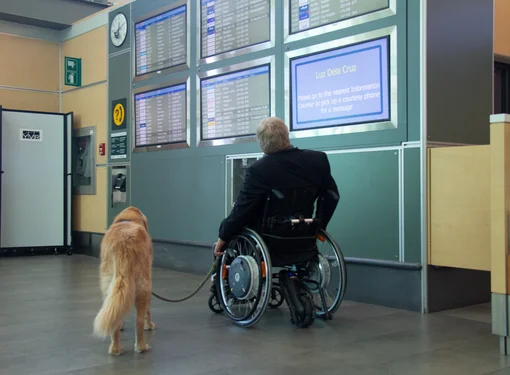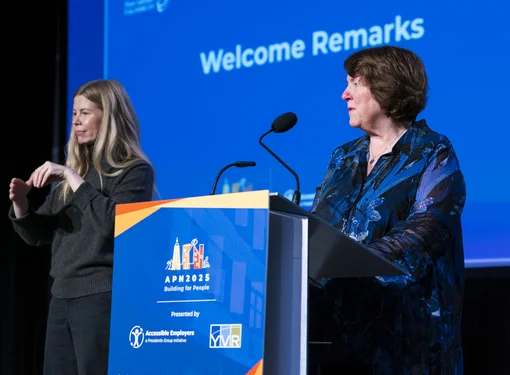Accessibility is Full-Charge Ahead for EVs
One of the aspects of electric vehicle ownership that piqued Jacques Courteau’s interest is the potential for accessibility.
Jacques, a wheelchair user, did his research. He found that electric vehicles (EVs) require very little maintenance compared to gasoline-burning cars. For starters, mechanical knowledge is not needed for typical do-it-yourself upkeep related to gas-powered vehicles, such as oil changes. It also cuts down on trips to the mechanic shop due to fewer moving parts, eliminating worry about not being able to use the shop’s loaner vehicle because there are no hand controls.
Jacques recently purchased a Tesla Model 3. He was initially frustrated by having to locate someone who could modify the car to accept acceleration and braking inputs through hand controls. Unlike several EV companies, Tesla does not have an in-house mobility program for people with disabilities, nor do they offer a rebate for adaptive hand controls.
Once Jacques hit the road, he discovered another issue with EV ownership – a lack of accessible charging stations.
“I placed my order for a Tesla when I did because they were offering free use of their Superchargers for life with the purchase of the vehicle,” he said. “Then, I started to realize that the chargers were not that accessible. The cable is heavy and the charging station is usually mounted on a curb.” Jacques added that non-Tesla direct current fast charger (DCFC) stations typically have screens on the chargers that are positioned out of reach for anybody in a wheelchair. Tesla Superchargers, on the other hand, have no buttons or anything requiring user interaction.
EV car owners already share a common trait called “range anxiety”—that sinking feeling of being on the road and wondering if your battery has enough juice to make it to the next charging station. Imagine, then, having a physical disability and wondering if you’ll even be able to access the charger when you get there.
EVs are not a passing fancy; they’re here to stay. In B.C., the number of registered EVs reached the 50,000 mark by the end of 2020 – a considerable increase over 2016’s registration numbers of 5,000. If EVs are the way of the future, as many predict, they must be inclusive of all users.

BC Hydro Builds an Understanding
In December 2019, the topic of accessibility was raised during a BC Hydro presentation to the Vancouver Electric Vehicle Association (VEVA). Jacques, a VEVA member, asked the Hydro representative if they knew that people with disabilities could not charge their vehicles at most of their 100 locations. They didn’t.
“Their reaction was amazing,” Jacques recalled. “They were so eager to do something about it.”
A team travelled with Jacques in his car to visit four charging stations around Vancouver. Monika Curman, the customer experience program manager for BC Hydro, said it was essential to learn first-hand from Jacques’s lived experience.
“We could have used published accessibility guidelines and gone from there,” she said. “We could have done it from behind a desk, but we knew that wasn’t enough. We really need to build an understanding by going out there and seeing for ourselves. One of my favourite quotes applies here, ‘If you’re stuck in your cubicle, you’re going to have cubicle-shaped thinking.’”
BC Hydro’s program manager for electric vehicles, Chris Trigardi, was also shocked at the inaccessibility of the DCFC charging stations. He and Monika watched the dangerous situation unfold as Jacques carried the heavy charging hose between his knees while navigating a hill.
The team, that included Jacques’ friend Donovan Whistler who is working with Jacques on building awareness about EV accessibility, also noticed how the protective bollards around the equipment were too close together. Jacques couldn’t maneuver in between to reach the touchscreen. The charging station was also up on a curb; one of the stations the team visited was even sitting on a platform surrounded by gravel.
Then there’s the issue of accessible parking. If none exist at the charging stations and somebody else parks next to the charging car, people using wheelchairs can’t get back into their vehicles, often having to wait for that person to come back and move their vehicle.
“Holy smokes, we realized how hard our designs were for him to access,” said Monika. “We knew we needed to get this right.”
“Our time with Jacques was impactful,” added Chris. “To this day, it has changed our way of thinking. It was unfortunate that we created these stations in such a way that they’re inaccessible, but now we know, and we have a new perspective and a new approach. This needed to happen.”
Driving Inclusion Forward
Accessibility is now included on BC Hydro’s priority list for improving driver experience.
“As someone who wears hearing aids, I am embarrassed because I felt like I should have been more in touch with accessibility concerns from the beginning,” said Monika. “It was a fleeting concern when our team went to Victoria for a meeting, and I saw people using walkers, which led me to wonder how they would use a charging station. The thought then just left my head, and I regret that so much.”
As many organizations and individuals attest, accessibility is a process; everybody has to begin somewhere. Accessibility also does not have a finish line as the needs of individuals change and technology evolves.
As new EVs are equipped with a higher battery capacity, BC Hydro will be upgrading their stations to 100 kW, which will charge the average vehicle in 20 minutes. Meaning, that the faster the charge, the bigger the cable has to be to manage water-cooling capabilities. Now that Chris is familiar with accessibility, he realizes that the next step also involves implementing a cable management system.
“The weight of these cables has been described as trying to carry around an anaconda,” said Chris. “The next thing on our list is how to incorporate a cable management system to ensure it’s easier for people who have accessibility issues, older people, and who are using crutches temporarily or a cane.”
Some countries, such as the United Kingdom, are investigating the possibility of dynamic wireless charging that utilizes pads that charge a car’s batteries when parked, eliminating the need for cables. While this could be in the future for EV charging in Canada, BC Hydro is focused on the near future that includes designs with shelters (it’s difficult for anybody to hold an umbrella while managing heavy cables), level and paved surface areas, and stations being built in a pull-through style similar to today’s gas stations to accommodate vehicles towing trailers as EVs become common-place.
One thing charging stations won’t have is designated accessible charging parking spots or accessible lanes to meet the Universal Design ethos of sites being created so they can be used to the greatest extent possible without needing adaptation or specialized design.
“You’re really taking care of everyone with good design,”
said Monika.
Jacques agreed, adding that Universal Design benefits everybody – not just people with disabilities.
“Do we have to make all the chargers accessible given that not everybody is disabled?” he asked. “Or do we go on the principle – and I think this is the right one – that it doesn’t cost any more to create and build an accessible charging station. There’s really no reason at all not to make them accessible.”






